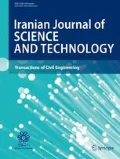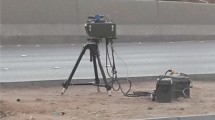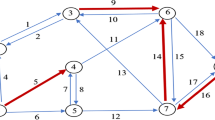Abstract
Sensor location problem on transportation network has been an interesting subject over the past few years. It is described as to optimally locate a certain number of given sensors in a network to minimize a defined cost function. Different sensor location methods have been developed; however, the probability of sensor failure has not been considered in most; if a sensor fails, the optimal deployment will not be plausible. Therefore, in this paper, the sensor failure probability is considered to place sensors optimally in order to find travel time estimation error. Moreover, it is attempted to provide optimal deployment by considering sensors failure, in which the travel time can be estimated using its upstream and downstream active sensors. To solve the proposed model, due to its complexity and diverse reported failure cases, the floating search method is used as an efficient approach in optimization problems. It has a much lower numerical complexity compared to other methods. The Sioux Falls network is adopted to test the proposed methodology. The results show that if one or more sensors fail, the remaining sensors will be in the best possible deployment, and travel time estimation error will be reduced as much as possible. Further, this study proposes a more accurate method for sensor optimal location by reducing travel time estimation error in the case of sensor failure.








Similar content being viewed by others
References
Asudegi M, Haghani A (2013) Optimal Number and Location of Node-Based Sensors for Collection of Travel Time Data in Networks Transportation Research Record: Journal of the Transportation Research Board. pp. 35–43
Ban X, Herring R, Margulici JD, Bayen AM (2009) Optimal sensor placement for freeway travel time estimation. In: Lam KWH, Wong CS, Lo KH (eds) Transportation and traffic theory 2009 Golden Jubilee papers selected for presentation at ISTTT18 a peer reviewed series since 1959. Springer, Boston pp. 697–721. doi:https://doi.org/10.1007/978-1-4419-0820-9_34
Fu C, Zhu N, Ling S, Ma S, Huang Y (2016) Heterogeneous sensor location model for path reconstruction. Transp Res Part B: Methodol 91:77–97. https://doi.org/10.1016/j.trb.2016.04.013
Gentili M, Mirchandani P (2012) Locating sensors on traffic networks: Models, challenges and research opportunities. Transp Res Part C: Emerg Technol. 24:227–255
Gentili M, Mirchandani PB (2018) Review of optimal sensor location models for travel time estimation. Transp Res Part C: Emerg Technol 90:74–96
Hadavi M, Shafahi Y (2016) Vehicle identification sensor models for origin–destination estimation. Transp Res Part B: Methodol 89:82–106. https://doi.org/10.1016/j.trb.2016.03.011
Kianfar J, Edara P (2013) Placement of roadside equipment in connected vehicle environment for travel time estimation. Transp Res Record 2381:20–27
Kim J, Park BB, Lee J, Won J (2011) Determining optimal sensor locations in freeway using genetic algorithm-based optimization. Eng Appl Artif Intell 24:318–324
Li X, Ouyang Y (2011) Reliable sensor deployment for network traffic surveillance. Transp Res Part B: Methodol 45:218–231
Li X, Ouyang Y (2012) Reliable traffic sensor deployment under probabilistic disruptions and generalized surveillance effectiveness measures. Oper Res 60:1183–1198
Moghaddam S, Hellinga B (2013) Quantifying measurement error in arterial travel times measured by bluetooth detectors transportation research record. J Transp Res Board 2395:111–122
Oh S, Choi K (2004) Optimal detector location for estimating link travel speed in urban arterial roads. KSCE J Civil Eng 8:327–333
Pudil P, Novovičová J, Kittler J (1994) Floating search methods in feature selection. Pattern Recognit Lett 15:1119–1125
Rajagopal R, Varaiya PP (2007) Health of California’s loop detector system. Institute of Transportation Studies, University of California at Berkeley, California PATH Program
Safaei A, Ha’iri-Yazdi MR, Esfahanian V, Esfahanian M, Masih Tehrani M, Nehzati H (2015) Designing an intelligent control strategy for hybrid powertrains utilizing a fuzzy driving cycle identification agent. Proc Inst Mech Eng, Part D: J Automob Engs 229:1169–1188
Shao M, Sun L, Shao X (2016) Sensor location problem for network traffic flow derivation based on turning ratios at intersection, Mathematical Problems in Engineering, 2016
Sherali HD, Desai J, Rakha H (2006) A discrete optimization approach for locating automatic vehicle identification readers for the provision of roadway travel times. Transp Res Part B: Methodol 40:857–871
Theodoridis S, Koutroumbas K (2009) Chapter 5 - Feature Selection. In: Theodoridis S, Koutroumbas K (eds) Pattern Recognition (Fourth Edition). Academic Press, Boston, pp 261–322. doi: https://doi.org/10.1016/B978-1-59749-272-0.50007-4
Transportation Networks for Research. Transportation Networks for Research Core Team. https://github.com/bstabler/TransportationNetworks
Updating comprehensive studies of urban transportation of Arak (In Persian) (2019). Arak Municipality, Iran
Zhu N, Ma S, Zheng L (2016) Travel time estimation oriented freeway sensor placement problem considering sensor failure. J Intell Transp Syst. https://doi.org/10.1080/15472450.2016.1194206
Author information
Authors and Affiliations
Corresponding author
Appendix
Rights and permissions
About this article
Cite this article
Dehestani Bafghi, R., Ahmadi, M. Reliable Traffic Sensor Deployment Considering Disruptions Using Floating Search Method. Iran J Sci Technol Trans Civ Eng 46, 1541–1552 (2022). https://doi.org/10.1007/s40996-021-00614-x
Received:
Accepted:
Published:
Issue Date:
DOI: https://doi.org/10.1007/s40996-021-00614-x





